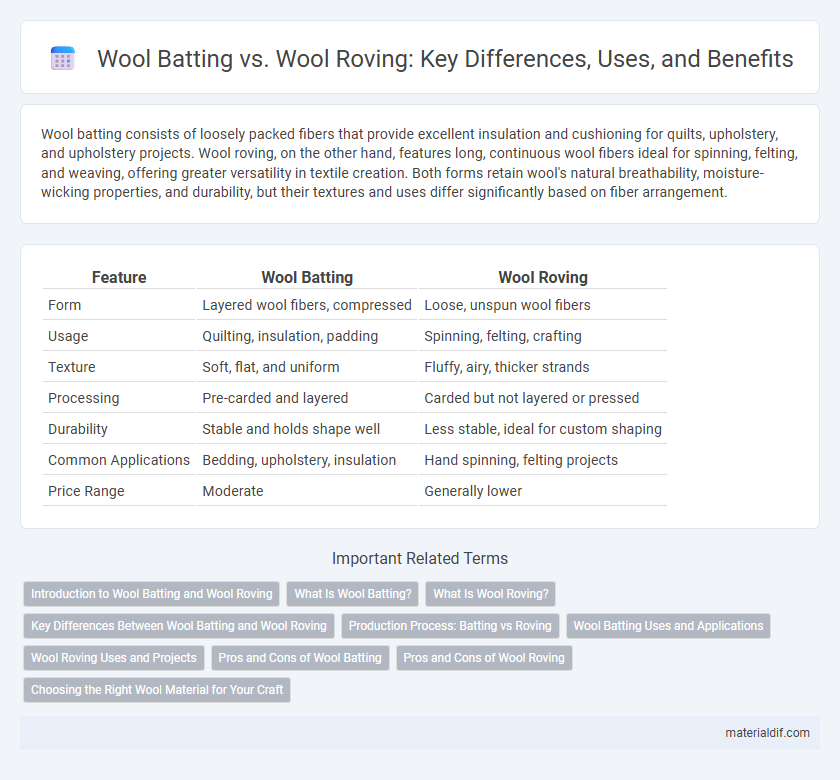Wool batting consists of loosely packed fibers that provide excellent insulation and cushioning for quilts, upholstery, and upholstery projects. Wool roving, on the other hand, features long, continuous wool fibers ideal for spinning, felting, and weaving, offering greater versatility in textile creation. Both forms retain wool's natural breathability, moisture-wicking properties, and durability, but their textures and uses differ significantly based on fiber arrangement.
Table of Comparison
| Feature | Wool Batting | Wool Roving |
|---|---|---|
| Form | Layered wool fibers, compressed | Loose, unspun wool fibers |
| Usage | Quilting, insulation, padding | Spinning, felting, crafting |
| Texture | Soft, flat, and uniform | Fluffy, airy, thicker strands |
| Processing | Pre-carded and layered | Carded but not layered or pressed |
| Durability | Stable and holds shape well | Less stable, ideal for custom shaping |
| Common Applications | Bedding, upholstery, insulation | Hand spinning, felting projects |
| Price Range | Moderate | Generally lower |
Introduction to Wool Batting and Wool Roving
Wool batting consists of layers of soft, carded wool fibers that are loosely pressed together, primarily used for insulation in quilting and upholstery due to its lightweight and breathable properties. Wool roving is a long, narrow bundle of combed wool fibers aligned in a parallel fashion, ideal for spinning, felting, and weaving projects because of its smooth texture and strong fiber integrity. Both wool batting and wool roving are natural, sustainable materials offering excellent moisture-wicking and temperature-regulating benefits for various textile applications.
What Is Wool Batting?
Wool batting consists of loosely packed, layered wool fibers that create a soft, insulating material widely used in quilting, upholstery, and insulation. Unlike wool roving, which is a continuous strand of fiber typically used for spinning and felting, wool batting provides loft and cushioning without being spun. Its natural elasticity, moisture-wicking properties, and thermal regulation make wool batting an eco-friendly choice for breathable, durable textile applications.
What Is Wool Roving?
Wool roving is a long, narrow bundle of carded wool fibers aligned in the same direction, often used for spinning yarn or felting projects. It retains more loft and texture compared to wool batting, which is compressed and layered for insulation or quilting. Wool roving offers greater versatility for crafting due to its loose, airy structure and ease of manipulation.
Key Differences Between Wool Batting and Wool Roving
Wool batting consists of thin layers of wool fibers that are carded and pressed together, ideal for insulation and quilting due to its consistent thickness and fluffy texture. Wool roving features long, continuous strands of combed wool, providing a smooth, dense material commonly used for spinning, felting, and crafting. The key differences lie in their preparation and application: wool batting offers loft and cushioning, while wool roving delivers a more compact and workable fiber suitable for detailed fiber arts.
Production Process: Batting vs Roving
Wool batting is produced by carefully carding wool fibers to align them loosely into a fluffy, flat sheet ideal for insulation and quilting, preserving fiber loft and softness. Wool roving undergoes a more intensive process where fibers are carded and then drawn out into long, continuous strands, creating a denser and more compact form used primarily for spinning and felting. The distinction in production lies in the carding technique and fiber alignment, resulting in batting's airy texture versus roving's smooth, elongated fiber structure.
Wool Batting Uses and Applications
Wool batting is commonly used in quilting, upholstery, and insulation due to its soft texture and excellent thermal properties. It provides natural moisture-wicking and breathability, making it ideal for bedding and garment lining. Unlike wool roving, wool batting is processed into a flat, dense sheet, enhancing its versatility for cushioning and soundproofing applications.
Wool Roving Uses and Projects
Wool roving is a versatile fiber commonly used in spinning, felting, and weaving projects due to its untwisted, elongated fiber structure that allows easy manipulation and blending. It is ideal for creating hand-spun yarn, needle felting sculptures, and soft, textured tapestries because it holds shape well and provides excellent insulation. Compared to wool batting, which is compressed and used mainly for quilting and insulation, wool roving offers greater flexibility and control for artistic and craft applications.
Pros and Cons of Wool Batting
Wool batting offers excellent insulation and moisture-wicking properties, making it ideal for quilting, upholstery, and insulation projects that require breathability and durability. It is easier to handle and shape compared to wool roving, yet it lacks the dense fiber structure of roving, which can reduce its suitability for felting and sculpting applications. Wool batting tends to be more affordable and available in uniform thicknesses, but it may experience more fiber migration and less elasticity than compact wool roving.
Pros and Cons of Wool Roving
Wool roving offers excellent flexibility and consistency, making it ideal for spinning, felting, and other fiber arts; its smooth texture facilitates easy drafting but may lack the loft and insulation properties found in wool batting. Unlike wool batting, which is layered and thick, wool roving is more compact and less resilient, potentially leading to less warmth and cushioning in finished products. The drawback of wool roving includes its higher cost and the necessity for skill in handling, as it can easily pull apart or felt unintentionally during processing.
Choosing the Right Wool Material for Your Craft
Wool batting offers a soft, insulated layer ideal for quilting and upholstery projects, providing warmth and cushioning with its fluffy, compressed fibers. Wool roving consists of long, untwisted wool strands perfect for felting, spinning, and detailed fiber art, allowing greater control over texture and shape. Selecting between wool batting and wool roving depends on your craft's specific needs, with batting suited for structural padding and roving ideal for sculptural or textile designs.
Wool Batting vs Wool Roving Infographic

 materialdif.com
materialdif.com